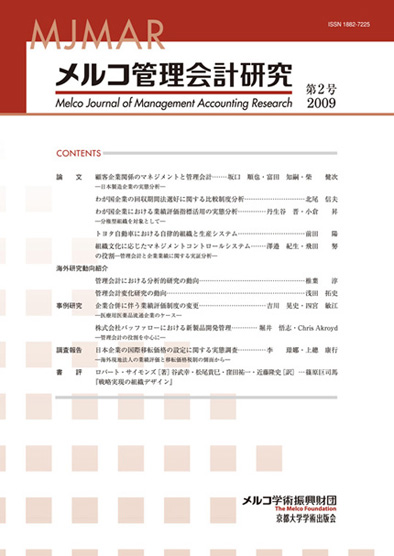Volume 2, Issue 1
Displaying 1-12 of 12 articles from this issue
- |<
- <
- 1
- >
- >|
research paper
-
2009 Volume 2 Issue 1 Pages 3-11
Published: 2009
Released on J-STAGE: November 17, 2015
Download PDF (649K) -
A Comparative Institutional Analysis of a Preference for Payback Period Method of Japanese Companies2009 Volume 2 Issue 1 Pages 13-21
Published: 2009
Released on J-STAGE: November 17, 2015
Download PDF (790K) -
2009 Volume 2 Issue 1 Pages 23-37
Published: 2009
Released on J-STAGE: November 17, 2015
Download PDF (951K) -
2009 Volume 2 Issue 1 Pages 39-52
Published: 2009
Released on J-STAGE: November 17, 2015
Download PDF (866K) -
2009 Volume 2 Issue 1 Pages 53-67
Published: 2009
Released on J-STAGE: November 17, 2015
Download PDF (823K)
research trend
-
2009 Volume 2 Issue 1 Pages 69-76
Published: 2009
Released on J-STAGE: November 17, 2015
Download PDF (679K) -
2009 Volume 2 Issue 1 Pages 77-85
Published: 2009
Released on J-STAGE: November 17, 2015
Download PDF (686K)
case study
-
2009 Volume 2 Issue 1 Pages 87-98
Published: 2009
Released on J-STAGE: November 17, 2015
Download PDF (1119K) -
2009 Volume 2 Issue 1 Pages 99-109
Published: 2009
Released on J-STAGE: November 17, 2015
Download PDF (433K)
survey report
-
2009 Volume 2 Issue 1 Pages 111-126
Published: 2009
Released on J-STAGE: November 17, 2015
Download PDF (795K)
book review
-
2009 Volume 2 Issue 1 Pages 127-134
Published: 2009
Released on J-STAGE: November 17, 2015
Download PDF (684K)
others
-
2009 Volume 2 Issue 1 Pages 135-136
Published: 2009
Released on J-STAGE: November 17, 2015
Download PDF (113K)
- |<
- <
- 1
- >
- >|
